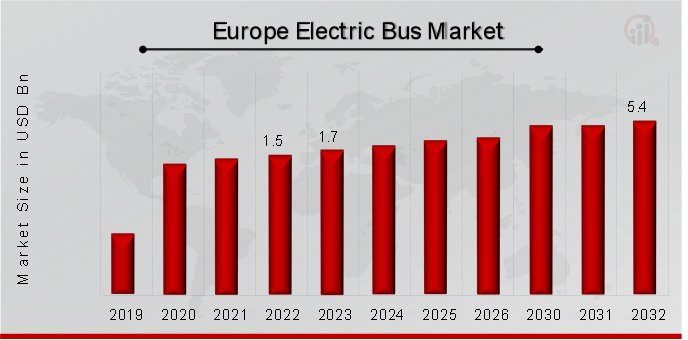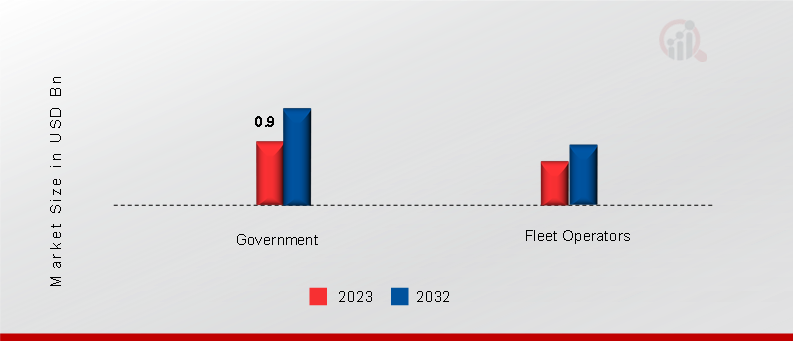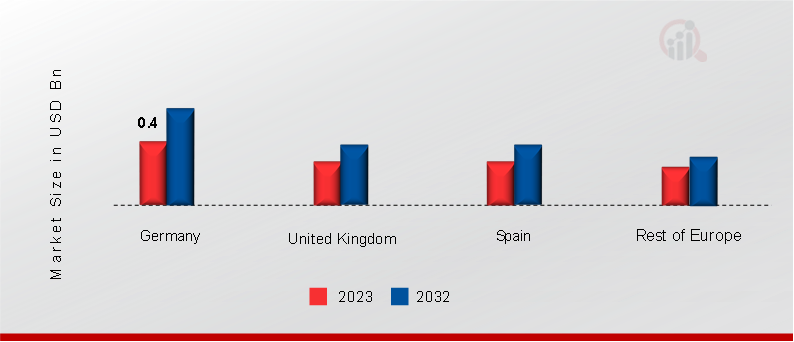Europe Electric Bus Market Overview:
Europe Electric Bus Market Size was valued at USD 1.5 Billion in 2022. The Electric Bus market industry is projected to grow from USD 1.7 Billion in 2023 to USD 5.4 Billion by 2032, exhibiting a compound annual growth rate (CAGR) of 15.20% during the forecast period (2024 - 2032). The Growing public awareness of the environment, coupled with increasing acceptance of sustainable transportation solutions, is driving the Europe electric bus market. As people become more informed about the detrimental effects of traditional diesel buses on air quality and public health, there is a growing demand for cleaner and greener alternatives.

Source: Secondary Research, Primary Research, MRFR Database and Analyst Review
Europe Electric Bus Market Trends
Growing public awareness of environmental is driving market growth
Growing public awareness of the environment, coupled with increasing acceptance of sustainable transportation solutions, is driving the European electric bus market. As people become more informed about the detrimental effects of traditional diesel buses on air quality and public health, there is a growing demand for cleaner and greener alternatives. Electric buses offer a promising solution, providing zero-emission transportation that improves air quality and reduces noise pollution in urban areas. Moreover, passengers are increasingly choosing electric buses for their eco-friendly attributes and smoother, quieter ride experience. As a result, public transportation authorities, cities, and communities are embracing electric buses as a vital component of their sustainable mobility strategies, driving the adoption and deployment of electric buses across Europe.
Increasing urbanization and congestion in European cities are driving the European electric bus market by creating a pressing need for sustainable public transportation solutions. As cities become more densely populated and traffic congestion worsens, there is a growing demand for transportation alternatives that reduce emissions and alleviate congestion. Electric buses offer a clean and efficient mode of public transportation that can help improve air quality, reduce noise pollution, and enhance mobility in urban areas. Moreover, electric buses can access city centers and low-emission zones where diesel vehicles are restricted, making them an attractive option for public transportation operators. Therefore, the need to address urbanization-related challenges and create livable, sustainable cities is driving the adoption and deployment of electric buses across Europe.
Europe Electric Bus Market Segment Insights:
Electric Bus Propulsion Type Insights
The Europe Electric Bus market segmentation, based on propulsion type, includes Battery Electric Bus, Plug-in Hybrid Electric Bus, and Fuel Cell Electric Bus. The Battery Electric Bus segment dominated the market. Battery electric bus propulsion has captured the largest market share in the Europe electric bus market due to its proven technology, widespread availability, and favorable economics. Battery electric buses offer zero-emission transportation with sufficient range to meet the demands of urban and suburban routes. Additionally, advancements in battery technology have improved energy density and reduced costs, making battery electric buses a cost-effective and environmentally friendly solution for public transportation operators across Europe.
Plug-in hybrid electric bus propulsion is experiencing the highest Compound Annual Growth Rate (CAGR) in the Europe electric bus market due to its versatility and transitional appeal. Plug-in hybrid buses offer the benefits of both electric and conventional propulsion systems, providing extended range and flexibility. They are particularly suitable for routes with longer distances or variable operating conditions, making them a preferred choice for public transportation operators seeking to transition to electric propulsion while ensuring operational reliability and flexibility.
Electric Bus Battery Type Insights
The Europe Electric Bus market segmentation, based on battery type, includes Lithium-ion, Nickel-Metal Hydride Battery (NiMH), and Others. The Lithium-ion category generated the most income. Lithium-ion batteries have captured the largest market share in the Europe electric bus market due to their superior energy density, longer lifespan, and faster charging capabilities compared to other battery types. Lithium-ion batteries offer sufficient power and range to meet the demands of electric buses operating in urban and suburban environments. Additionally, advancements in lithium-ion battery technology have led to reductions in cost and improvements in performance, making them the preferred choice for electric bus propulsion in Europe.
Nickel-Metal Hydride (NiMH) batteries are experiencing the highest Compound Annual Growth Rate (CAGR) in the Europe electric bus market due to their reliability, safety, and proven track record in automotive applications. While lithium-ion batteries dominate the market, NiMH batteries are gaining traction in certain segments due to their lower cost, stable performance, and established infrastructure for recycling and disposal. Additionally, some public transportation operators favor NiMH batteries because of their familiarity and compatibility with existing electric bus fleets.
Electric Bus Consumer Type Insights
The Europe Electric Bus market segmentation, based on consumer type, includes Government and Fleet Operators. The Government category generated the most income. Government consumers have captured the largest market share in the European electric bus market due to their significant role in public transportation procurement and sustainability initiatives. Governments at national, regional, and local levels are leading the transition to electric buses by setting ambitious targets, providing financial incentives, and implementing regulations favoring zero-emission vehicles. Public transportation agencies and municipalities procure electric buses to meet environmental goals, improve air quality, and enhance the quality of life for citizens across Europe.
Fleet operators are experiencing the highest Compound Annual Growth Rate (CAGR) in the Europe electric bus market due to several factors. They are increasingly recognizing the benefits of electric buses, including lower operating costs, reduced emissions, and enhanced sustainability. Additionally, advancements in electric bus technology, coupled with supportive government policies and incentives, make electric buses a compelling choice for fleet operators looking to modernize their fleets and meet environmental regulations while improving their bottom line.
Figure 1: Europe Electric Bus Market by Consumer Type, 2023 & 2032 (USD Billion)

Source: Secondary Research, Primary Research, MRFR Database and Analyst Review
Electric Bus Country Insights
In Europe's electric bus market, certain countries stand out for their dominance and leadership in electric bus adoption and deployment. Nordic countries, particularly Sweden and Norway, lead the market with extensive electrification efforts supported by robust government policies, substantial investments in charging infrastructure, and strong public awareness of environmental issues. Germany, with its renowned automotive industry and commitment to sustainability, plays a pivotal role in driving electric bus innovation and deployment. Additionally, the Netherlands, known for its progressive transportation policies and initiatives, serves as a model for sustainable mobility practices, further cementing its dominance in the European electric bus market.
Figure 2: Europe Electric Bus Market Share By Country 2023 & 2032 (USD Billion)

Source: Secondary Research, Primary Research, MRFR Database and Analyst Review
Electric Bus Key Market Players & Competitive Insights
Leading players are actively engaged in developing and deploying innovative electric bus solutions. Companies like BYD, Volvo Group, and Daimler are investing in the market developments of electric bus models with advanced battery technology and energy-efficient drivetrains. Additionally, manufacturers such as Solaris, VDL Bus & Coach, and Irizar are expanding their electric bus offerings and collaborating with government agencies and public transportation operators to deploy electric buses in cities across Europe, driving the transition towards sustainable mobility In the European electric bus market.
Major players in the Electric Bus market are attempting to increase market demand by investing in research and development operations, including BYD Company Limited, Volvo Group, Daimler AG, Solaris Bus & Coach, VDL Bus & Coach, Irizar Group, MAN Truck & Bus, Iveco Bus, Alexander Dennis Limited, and Van Hool NV.
Key Companies in the Europe Electric Bus market include
- BYD Company Limited
- Volvo Group
- Daimler AG
- Solaris Bus & Coach
- VDL Bus & Coach
- Irizar Group
- MAN Truck & Bus
- Iveco Bus
- Alexander Dennis Limited
- Van Hool NV
Europe Electric Bus Industry Developments
June 2022: Van Hool unveiled its latest lineup of emission-free public buses, the A-Series, at the European Mobility Expo in Paris. This new range of buses offers both battery-electric and fuel cell (hydrogen) powertrain options. The A-Series includes models in four different lengths (12m, 13m, 18m, and 24m), each equipped with two to five passenger doors.
Europe Electric Bus Market Segmentation:
Electric Bus Propulsion Type Outlook
- Battery Electric Bus
- Plug-in Hybrid Electric Bus
- Fuel Cell Electric Bus
Electric Bus Battery Type Outlook
- Lithium-ion
- Nickel-Metal Hydride Battery (NiMH)
- Others
Electric Bus Consumer Type Outlook
- Government
- Fleet Operators
Electric Bus Regional Outlook
- Europe
- Germany
- France
- UK
- Italy
- Spain
- Sweden
- Denmark
- Luxembourg
- Norway
- Austria
- Rest of Europe
| Report Attribute/Metric |
Details |
| Market Size 2022 |
USD 1.5 Billion |
| Market Size 2023 |
USD 1.7 Billion |
| Market Size 2032 |
USD 5.4 Billion |
| Compound Annual Growth Rate (CAGR) |
15.20% (2024-2032) |
| Base Year |
2023 |
| Market Forecast Period |
2024-2032 |
| Historical Data |
2019- 2022 |
| Market Forecast Units |
Value (USD Billion) |
| Report Coverage |
Revenue Forecast, Market Competitive Landscape, Growth Factors, and Trends |
| Segments Covered |
Propulsion Type, Battery Type, Consumer Type, and Region |
| Region Covered |
Europe |
| Countries Covered |
Germany, France, UK, Italy, Spain, Sweden, Denmark, Luxembourg, Norway, Austria and Rest of Europe |
| Key Companies Profiled |
BYD Company Limited, Volvo Group, Daimler AG, Solaris Bus & Coach, VDL Bus & Coach, Irizar Group, MAN Truck & Bus, Iveco Bus, Alexander Dennis Limited, and Van Hool NV |
| Key Market Opportunities |
Expanding operations and entering new markets in Europe and beyond presents opportunities for companies to capitalize on the growing demand for electric buses |
| Key Market Dynamics |
Growing Public Awareness and Acceptance Increasing Urbanization and Congestion |
Frequently Asked Questions (FAQ) :
The Europe Electric Bus market size was valued at USD 1.7 Billion in 2023.
The market is projected to grow at a CAGR of 15.20% during the forecast period, 2024-2032.
The key players in the market are BYD Company Limited, Volvo Group, Daimler AG, Solaris Bus & Coach, VDL Bus & Coach, Irizar Group, MAN Truck & Bus, Iveco Bus, Alexander Dennis Limited, Van Hool NV, Ebusco, CaetanoBus, Yutong Group, Zhongtong Bus Holding Co., Ltd. and Temsa Global, among others.
The battery electric bus bonding category dominated the market in 2023.
The lithium-ion category had the largest share of the market.




























